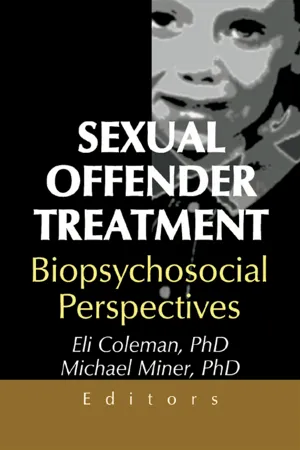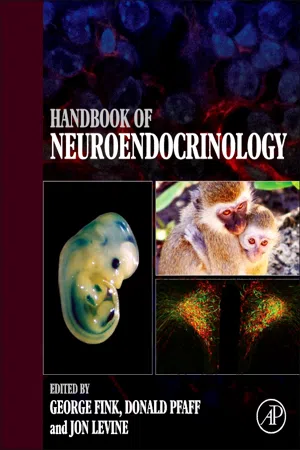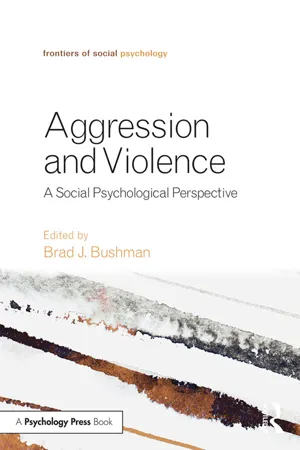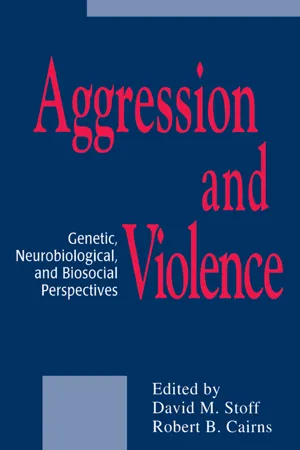Psychology
Neural and Hormonal Mechanisms in Aggression
Neural and hormonal mechanisms in aggression refer to the biological processes that influence aggressive behavior. These mechanisms involve the interplay of brain structures, neurotransmitters, and hormones such as testosterone and cortisol. Research in this area aims to understand how these biological factors contribute to the expression and regulation of aggression in humans and animals.
Written by Perlego with AI-assistance
Related key terms
8 Key excerpts on "Neural and Hormonal Mechanisms in Aggression"
- eBook - ePub
Sexual Offender Treatment
Biopsychosocial Perspectives
- Edmond J Coleman, Michael Miner(Authors)
- 2014(Publication Date)
- Routledge(Publisher)
In animals several categories of aggressive behavior can be identified such as offensive, defensive, predatory, fear-induced, territorial, irritable, sex-related and maternal aggression (Albert, Walch & Jonik, 1993). It is an unresolved question whether all these categories have distinct neurological and hormonal systems underlying their biological execution and what the counterparts are in the human. This question is of interest since a thorough understanding would allow to identify biological predispositions to (sexual) aggression and violence. A better understanding of the neurobiology of (sexual) aggression in terms of neurotransmitters and hormones would allow the development of pharmacological treatment modalities. Together with other treatment strategies (psychological treatment, social rehabilitation), this could help individuals to control their aggressive impulses and to help them to lead more meaningful lives with respect of the rights of their fellow human beings.This contribution will address three areas of biological research, which have links with the biology of (sexual aggression):- Androgen-related (sexual) aggression. The role and importance of androgens is often misconceptualized, This contribution will argue that androgens as such show no consistent relation with aggression. Its main function is to lower the threshold for sexual events to occur. If sexual events are of an aggressive nature in an individual's life, they may become better amenable with pharmacological intervention reducing the biological effects of androgens.
- Aggression may be related to anatomical or functional disorders of certain brain areas.
- Aggression as a stress response disorder. A fascinating area of research is the psychoneuroendocrine substrate of stress. There have been major advances over the last decades. The biological systems of human beings and animals alike, are not closed systems; there is an interaction with the environment. Every internal and external stimulus is interpreted and assessed. Life exists by maintaining a complex dynamic equilibrium, or homeostasis, that is constantly challenged by extrinsic and intrinsic adverse forces (Stratakis & Chrousos, 1994). The organism reacts to this threatened homeostasis with the activation of a complex of behavioral responses evoking fright, flight or fight as defense mechanisms, to preserve integrity. This contribution argues that aggression and violence are maladaptive response mechanisms in reaction to intrinsic and extrinsic stimuli of a system that in essence is designed to confer protection to an organism.
- eBook - ePub
- George Fink, Donald W. Pfaff, Jon Levine(Authors)
- 2011(Publication Date)
- Academic Press(Publisher)
Chapter 22. Neuroendocrinology of AggressionBrian C. Trainor1 and Randy J. Nelson2
1 Department of Psychology, University of California, Davis, CA, USA2 Departments of Neuroscience and Psychology, Ohio State University, Columbus, OH, USAOutline
Introduction509Neural Circuits of Aggression510Effects of Steroids on Aggressive Behavior510Androgens510Estrogens512Neurosteroids512DHEA514DHEA514Glucocorticoids515Effects of Protein and Peptide Hormones on Aggressive Behavior516Vasopressin516Oxytocin516Prolactin516Conclusions516SummaryAggressive behaviors are often assumed to be regulated by testosterone. However, after a century of research it is becoming clear that there is a complex network of neuroendocrine pathways that can regulate aggressive behaviors. This network of steroid and peptide hormones allows for aggressive behaviors to be modified in response seasonal, reproductive and social information. We review the effects of steroids (gonadal, adrenal and neurosteroids) and neuropeptide hormones on aggressive behaviors. Many of these hormones only exert an effect on behavior within a defined environmental context, and we explore the complex interactions between hormones, the environment and behavior. Studies of the neuroendocrine bases of aggressive behavior have provided important insights into how complex behaviors are regulated by hormones. These discoveries may also eventually lead to practical applications, as dysregulated aggression is a component of several mental disorders.Introduction
Neuroendocrinology is the interaction between the nervous and endocrine systems. Traditionally, this field has relied on behavioral changes as the “read-out” in response to manipulations of endocrine signals. Aggressive behaviors have been a focus of many neuroendocrine studies for a variety of reasons, including sex differences in aggression, increased aggression at puberty, and coincidence of aggression with the onset of the breeding season. Males are more aggressive than females in most vertebrate species (although exceptions have been reported), and aggression is associated with the breeding season (again with some notable exceptions, detailed below). Indeed, in the first documented neuroendocrine experiment, Professor Arnold Adolph Berthold, at the University of Göttingen, demonstrated experimentally that a product of the testes was necessary for young roosters to develop typical mating, vocalizing and aggressive behaviors in adulthood. 1 - eBook - ePub
Aggression and Violence
A Social Psychological Perspective
- Brad J. Bushman(Author)
- 2016(Publication Date)
- Routledge(Publisher)
But the link between serotonin and aggression is more complicated than it might seem. A recent review summarized and integrated laboratory findings in cats, rodents, and humans and concluded that serotonergic neurotransmission in the hypothalamus, among other mechanisms, distinguishes reactive/emotional aggression from proactive/low-arousal aggression (Haller, 2013). Specifically, reactive, high-arousal aggression is associated with increased activation in the mediobasal portion of the hypothalamus, which is accompanied by increased vasopressinergic and decreased serotonergic neurotransmission. In aggression models associated with low arousal (unemotional/proactive aggression), the lateral but not the mediobasal hypothalamus is over-activated and the link between aggression and serotonergic neurotransmission is lost. This conclusion accords with previous findings showing that serotonin influences impulsive (but not planned) aggression (see Berman et al., 1997).Neural Responses Associated with Aggression
Thus far, the current chapter has focused primarily on evidence of the neural foundations of aggression from studies in which neural structure and function have been manipulated, either naturally (i.e., via injury) or in laboratory lesion and neural activation studies. Another class of studies from cognitive and behavioral neuroscience involves measuring naturally occurring neural responses either as aggressive behaviors are enacted or as environmental cues associated with aggression are processed. Work of this type is important for establishing links between aggression-related triggers in the environment and the neural processes that give rise to overt behavioral expression of aggression. This section provides a brief review of some of that research.A considerable amount of human aggression research is concerned with factors in the external environment (e.g., perceiving hostility in others; witnessing others’ aggressive acts; seeing others in pain) that are believed to elicit aggressive or anti-aggressive (i.e., empathic or prosocial) behavioral responses. Studies of this type often involve participants being asked to view violence-related stimuli while their brain activity is measured. For example, one correlational study found that repeated viewing of violence in the media is associated with reduced neural responding to depictions of real-life violence, seen as attenuated amplitude of the P3 (or P300) component of the event-related brain potential (ERP) when violent images are shown (Bartholow et al., 2006). An experimental study showed that, among participants who typically do not expose themselves to large amounts of media violence, playing a violent video game (versus a nonviolent game) in the lab for 25 minutes also reduced the P3 response to images of violence (Engelhardt et al., 2011). ERPs represent electrical responses generated by the postsynaptic firing of (primarily cortical) neurons during information processing (see Fabiani et al., 2007). The P3 is a voltage deflection occurring roughly 300–700 ms following the onset of a stimulus (e.g., an image of violence), which has been associated with the activation of approach and avoidance motivational systems in response to positive and negative images (e.g., Hilgard et al., 2014; Schupp et al., 2000; Weingberg & Hajcak, 2010). Thus, the findings reported by Bartholow and colleagues (2006; Engelhardt et al., 2011) suggest that exposure to virtual violence can lead to desensitization of avoidance motivational responses to real-life violence (also see Bailey et al., 2011). - eBook - ePub
Physiological Psychology
An Introduction
- Simon Green(Author)
- 2016(Publication Date)
- Routledge(Publisher)
Not all forms of aggressive behaviour are amenable to cholinergic manipulation. Earlier in the chapter I pointed out that aggressive behaviour is not homogeneous; subtypes may be distinguished in terms of their topology (i.e. the precise form the behaviour takes) and their physiological substrates. A single example of aggression depends upon an intricate series of stimulus-response linkages, and therefore upon sensory and motor processes coordinated by a central mechanism. Obviously no one brain structure and no one neurotransmitter pathway will have exclusive control over such a complex behaviour as animal aggression.Before leaving aggression, two areas of research, lying outside the scope of this book, should be mentioned. Endocrine studies show that hormones can play a significant role in aggression and other emotions. The presence of testosterone in the urine is a key trigger for aggressive behaviour in rats (Adams, 1979). Mouse-killing is seen only in male rats, and is abolished by castration (Avis, 1973), showing its dependence upon male hormones (androgens) such as testosterone. There are few sound studies of testosterone and aggression or criminality in humans, and no particular correlation emerges (Goldstein, 1974). A more general role for hormone levels in emotion is suggested by the mood changes seen in females during the menstrual cycle and occasionally observed after taking high-oestrogen contraceptive pills. These effects are likely to be mediated centrally as the brain contains a network of sites selectively responsive to hormone levels in the bloodstream.Aggressive behaviour in animals can be systematically manipulated by breeding programmes. If mice either high or low in aggression are inbred, significant differences in aggressive behaviour between the groups emerge by the third generation. Similar results have been reported in dogs (Scott, 1958). Scott also demonstrated an interaction with the environment; ‘aggressive’ pups raised with an ‘aggressive’ mother showed more aggressive behaviour than ‘aggressive’ pups raised with a ‘docile’ mother. - eBook - ePub
Aggression and Violence
Genetic, Neurobiological, and Biosocial Perspectives
- David M. Stoff, Robert B. Cairns(Authors)
- 2014(Publication Date)
- Psychology Press(Publisher)
Fig. 13.1 . In those instances when both biological and behavioral processes described or explained a developmental process, the integration tended to be deterministic: Biology determines behavior. In the case of aggression, the androgen testosterone (T), for instance, tended to be viewed as a causal agent in aggressive behavior. Recent discoveries in the field of animal behavior and physiology have provided a rationale for the conviction that unidirectional cause–effect thinking between physiology and behavior is far too limiting. This realization has a parallel in the age-old controversy of nature-nurture. The dualism of nature and nurture may be one of convenience rather than reality. Nature and nurture, like physiology and behavior, or hormones and behavior, are most easily studied as components of a larger system by scientists who have tools to assess one aspect of the dualism better than the other.Fig. 13.1 Models used to conceptualize hormones and behavior: hormone to behavior (a), behavior to hormone (b), reciprocal hormones-behavior relations (c), and mediators of hormone and behavior relations (d).Contrary to these past approaches, the progression of biological and behavioral research as separate entities now is evolving into a biology–behavior synthesis as reflected in recent theoretical perspectives (Gunnar, 1987 ; Susman, 1993 ) and the content of this volume. In the case of aggression, the perspective proposed here is that aggressive tendencies constitute multicausal phenomena. To understand physiological processes and aggression, these processes should not be viewed as separate causal entities. Physiological processes can be viewed as causes, consequences, or mediators of the psychological constructs of development. Magnusson and Cairns (1992) propose that this multidirectional perspective replaces a “paste on” approach to biological variables that has been prominent in the past.Neuroendocrine processes as consequences or mediators of development have not been represented historically in behavioral endocrinology. The traditional experimental approach to understanding the effects of hormones on behavior is to remove the source of the hormone (ablation), to administer exogenous hormones (replacement), and to measure the effects of the exogenous hormone on behavior. This unidirectional model appears in Fig. 13.1a . The following animal-model example illustrates the effect of hormones on behavior while highlighting the importance of the timing of hormone exposure and behavior. Primus and Kellog (1990) - eBook - ePub
Social Neuroscience
Biological Approaches to Social Psychology
- Eddie Harmon-Jones, Michael Inzlicht, Eddie Harmon-Jones, Michael Inzlicht(Authors)
- 2016(Publication Date)
- Routledge(Publisher)
Anderson & Bushman, 2002 ) that describe distinct observable behaviors. Proactive aggression is instrumental and premeditated, and while associated with achieving a particular goal, is not associated with goal frustration or perceived threats. In contrast, reactive aggression is not premeditated and involves anger and responding to social threats and frustrated goals.We begin this review by discussing the evidence for the involvement of the steroid hormones testosterone and cortisol in guiding and executing angry and aggressive actions. Then we recapitulate the core assumptions and theoretical basis of the Triple Imbalance Hypothesis, which proposes that socially aggressive actions are underpinned by three interacting systems of the brain, and that imbalances within these systems are associated with an increased proclivity to act aggressively in response to perceived threats and when seeking rewarding stimuli (van Honk et al., 2010 ). Then we review recent research on reactive aggression which discusses the role that each of the three brain systems have in motivating and facilitating reactive aggression. Finally, we discuss evidence for the role of the corpus callosum in mediating imbalances in the most recently evolved of these brain systems.Core Brain Chemicals for Reactive Aggression
A promising approach to modeling neuroendocrine contributions to anger and reactive aggression in humans has focused on the mutually antagonistic effects of testosterone and cortisol (van Honk et al., 2010 ). In non-human species, testosterone levels are reliably associated with increased aggression toward conspecifics, and they predict sex differences in socially aggressive behavior (Archer, 1988 ). In humans, greater testosterone levels have been found to predict aggressive attitudes, with castration reducing their endorsement (Van Goozen, Cohen-Kettenis, Gooren, Frijda, & Van De Poll, 1995 ). Moreover, situationally increased testosterone levels in response to a laboratory anger induction predict increased self-reported anger to the induction (Peterson & Harmon-Jones, 2012 ). Additional evidence for the role of testosterone in shaping anger and aggressive behavior in humans comes from a program of research associating testosterone levels with observer-rated violence and aggressive antisocial behavior in male and female prison populations (Dabbs, Carr, Frady, & Riad, 1995 ; Dabbs & Hargrove, 1997 ; Dabbs & Morris, 1990 ). Intriguingly, because of the putative mechanism by which testosterone affects aggression, its effects may not be consciously accessible or observed in self-report (van Honk & Schutter, 2007a ). In contrast to testosterone, cortisol has been associated with a reduced tendency to engage in aggressive behaviors. Lower levels of cortisol are observed in populations at risk of violent antisocial outbursts and children with socialization problems (McBurnett et al., 1991 ; Vanyukov et al., 1993 - eBook - ePub
Crime and Criminality
A multidisciplinary approach
- Sandie Taylor(Author)
- 2015(Publication Date)
- Routledge(Publisher)
• Bio-neurochemical research considers the effects of hormones and neurotransmitters on antisocial and criminal behaviour. Sex hormones, such as androgens, have been researched extensively in relation to aggression. Testosterone in males and oestrogens controlling the menstrual cycle in females have been associated with violent and aggressive behaviour. Most research has focused on testosterone in males and shows that the higher the levels of testosterone the more likely the individual is to be prone to violence. Other hormones, such as insulin, have been found to influence aggressive behaviour also. Effects of neurotransmitters, such as noradrenaline, serotonin and dopamine, on aggressive and antisocial behaviour provide proximate (i.e. a here and now mechanistic approach) explanations. Low levels of cerebrospinal serotonin are implicated in impulsive aggressive behaviour whereas high levels of noradrenaline are implicated in aggressive and violent behaviour.• Brain imaging studies have provided researchers with a view to the structure and functioning of the brain. Both structural and functional differences in the amygdala, corpus callosum, frontal and temporal lobes have been found in those with antisocial and aggressive behaviour. In the case of individuals with antisocial behaviour, low arousal of the frontal lobes has been observed. The amygdala is important for cyphering fear and interpreting people’s feelings under different social situations. This might account for how predatory murderers can be so callous in their killings. Various researchers have alluded to there being different types of murderers: affective who are impulsive killers and predatory who plan their killings. The question posed by Raine et al - eBook - ePub
An Introduction to Social Psychology
Global Perspectives
- James Alcock, Stan Sadava(Authors)
- 2014(Publication Date)
- SAGE Publications Ltd(Publisher)
For example, androgens also enhance musculature and increase available energy, and how this increased physique and energy are employed depends on socialization (Eagly & Steffen, 1986). (This muscle-building and energizing feature of testosterone made it the hormone of choice for some athletes before drug regulations and drug-testing policies were introduced.) Moreover, testosterone level is actually influenced by social factors, including the perception and interpretation of a situation; research suggests that cues related to aggression may trigger a higher testosterone level, which in turn may make an aggressive response more likely. For example, in one experiment (Klinesmith, Kasser & McAndrew, 2006), male participants who handled a gun experienced a greater increase in testosterone levels than did those in a control condition. Thus, whatever relationship there is between testosterone and aggression, it is undoubtedly a complex one involving not only biological but also social and cultural factors as well. Key Point: Testosterone appears to play a significant role in some aggressive behaviours, but does not on its own explain human aggression. Social roots While genes, brain structure and hormones play a role, they can only partially account for why some individuals manifest much more aggression than do others, and attempts to explain aggression only in terms of biological factors overlook the very powerful influences of both social learning and social structure within a society. Social learning theory According to social learning theory, it is through both direct reinforcement of their behaviour and imitation of others that children learn how to aggress, when to aggress, and against whom to aggress (Bandura, 1973). Most research has shown that early life is a particularly critical time for learning about aggression (Olweus, 1972)
Index pages curate the most relevant extracts from our library of academic textbooks. They’ve been created using an in-house natural language model (NLM), each adding context and meaning to key research topics.







